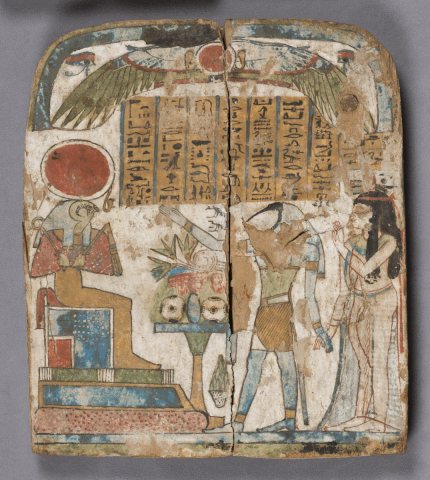Last week we described how conservators in the BKM conservation lab have been combining analytical t
Last week we described how conservators in the BKM conservation lab have been combining analytical techniques to identify and map indigo blue pigments without sampling. As we mentioned in our earlier post, we have also been using Visible-Induced Luminescence imaging to map the presence of Egyptian blue on ancient Egyptian objects.Ordinarily when we image Egyptian blue, we have a clear map of the pigments, such as on these two funerary stelae we recently photographed (above). Bright white regions correspond to the use of Egyptian blue. In some cases, however, the results are a bit more subtle. On the footcase we spoke about last week, the traces of Egyptian blue pigment are very faint. Although there is only a small amount of the pigment in the paint mixtures and it is highly dispersed, they shine brightly like stars in the sky and are identifiable. You just need to zoom in quite closely to really get an idea of where the pigment particles are located.Looking at the image above, we can see that there is Egyptian blue concentrated on the figure at the right. When zooming out on the overall image, we also saw it in the outlines of the feet, and in certain stripes and border elements. Indeed, the stripes that appear the same color as the slightly reddish-pink of the right hand figure appear to contain similar amounts of Egyptian blue, while in the other striped border elements Egyptian blue is notably absent. When comparing this to the indigo image from last week, we see some interesting patterns!The blue bands outlining the feet, and the decorative bands below the prisoners, as well as the star banner across the top contain both indigo and Egyptian blue. The indigo regions in the top and bottom corners (seen in white in the image above), however, do not contain Egyptian blue. In some areas, there are a few scattered particles of Egyptian blue, such as in the hair. This is a bit more difficult to interpret as it may be traces of pigment in the brush or possibly a purposefully applied under layer.In any case, this is an excellent example of how complex paint and pigment analysis can be—and we’ve only been talking about the blues and blue mixtures, not to mention the remainder of colorants on this fascinating footcase!Posted by Dawn Kriss and Sara Levin -- source link
#bkmconservation#bkmegyptianart#blue#egyptian blue#infinitebluebkm#mixture#pigment#colorant#mbi#conservation#art conservation#conservator#museums#art#science#indigo#visible-induced luminescence#imaging#ancient#objects#paint#highlight


